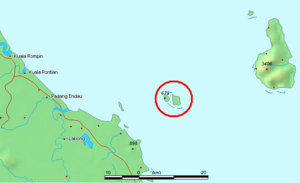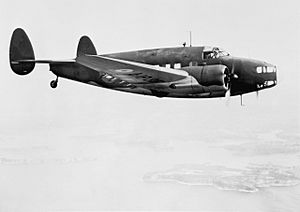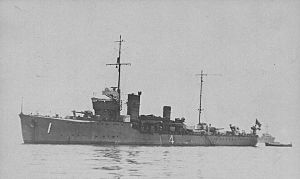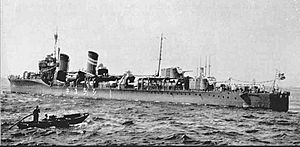Battle off Endau facts for kids
Quick facts for kids Battle off Endau |
|||||||
|---|---|---|---|---|---|---|---|
| Part of the Battle of Malaya | |||||||
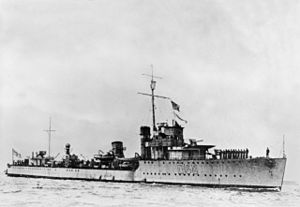 HMAS Vampire, c. 1940, seen here before the application of wartime camouflage |
|||||||
|
|||||||
| Belligerents | |||||||
| Commanders and leaders | |||||||
| Shintarō Hashimoto | |||||||
| Units involved | |||||||
| Naval: 1st Escort Unit Air: 1st Air Squadron 11th Air Squadron |
Naval: Air: No. 36 Squadron RAF No. 62 Squadron RAF No. 100 Squadron RAF No. 1 Squadron RAAF No. 8 Squadron RAAF |
||||||
| Strength | |||||||
| 1 light cruiser 6 destroyers 5 minesweepers 3 subchasers 4 converted patrol ships 2 troopships 2 auxiliary ships 32 fighters |
2 destroyers 21 fighters 15 light bombers 22 torpedo bombers |
||||||
| Casualties and losses | |||||||
| 8 killed 18 wounded |
1 destroyer sunk 39 killed 33 captured |
||||||
The Battle off Endau was a naval battle during Second World War. It happened near Endau town in Malaya on January 26–27, 1942. This battle was part of the larger Battle of Malaya.
It was the first important naval fight after the sinking of two big British warships in December 1941. It was also the last time the Royal Navy tried to stop Japanese ships carrying supplies around the Malay Peninsula.
On January 26, 1942, reconnaissance aircraft spotted a Japanese convoy heading towards Endau. Allied planes attacked the convoy many times as it was landing troops. The Allies lost many planes, but the Japanese lost only one.
Later that day, the Royal Navy sent two destroyers to stop the Japanese landings. The Japanese had a much larger group of escort ships. The Allied destroyers sailed in the dark and found the convoy without being seen. But they could not find the troopships in the darkness.
The Allied ships tried to leave, but the Japanese escort ships fired at them. One Allied destroyer was sunk early on January 27.
Contents
Why the Battle Happened
The Malayan Campaign started with the sinking of two important British warships, Prince of Wales and Repulse. This meant that stopping Japanese convoys in the Gulf of Siam was left to submarines from the Royal Netherlands Navy. Other Allied surface ships were busy protecting convoys going to and from Ceylon and the Dutch East Indies.
Dutch submarines had some success. For example, the troopship Awazisan Maru was sunk near Kota Bharu on December 12, 1941. On December 24, HNLMS K XVI sank the destroyer Sagiri off Kuching, Borneo. Even though some Japanese ships were damaged or sunk, the Dutch submarines also suffered many losses. They could not stop the Japanese advance.
Endau: The Location
The Japanese army first planned to land troops at Mersing. This would cut off the British forces from Singapore. But the Southern Expeditionary Army Group decided to land the rest of their 18th Division at Singora instead. They thought the Allied defenses at Mersing were too strong.
Even though Japanese ground forces captured Endau on January 21, they were not strong enough to break through the Australian defenses at Sungei-Mersing.
On January 20, 1942, a group of eleven troopships left Cam Ranh Bay, Indochina. They were carrying soldiers to Singora. Two of these ships, Kansai Maru and Canberra Maru, were going to Endau. They carried troops who would get the airfields at Kahang and Kluang ready for use.
These ships were protected by the 1st Escort Unit. This unit included the light cruiser Sendai, which was the main ship of Rear-Admiral Shintarō Hashimoto. It also had six Fubuki-class destroyers: Fubuki, Hatsuyuki, Shirayuki, Asagiri, Amagiri, and Yūgiri.
The escort group also had five W-1-class minesweepers, three CH-4-class submarine chasers, and four converted patrol boats.
Air Attacks on the Convoy
Malaya Command expected the Japanese to send more ships. This was confirmed on January 26 when two Royal Australian Air Force (RAAF) Lockheed Hudson aircraft spotted the convoy. They were about 20 miles (32 km) north of Endau.
The planes saw the Japanese convoy at 7:45 AM. But their radios were jammed, so the news did not reach headquarters until they landed in Singapore at 9:20 AM. The RAF decided to attack the convoy with all available planes.
The attack had to wait until that afternoon. This was so the crews of the Vickers Vildebeest and Fairey Albacore torpedo bombers could rest. These planes were from No. 36 Squadron RAF and No. 100 Squadron RAF. The pilots were surprised that they had to use the old Vildebeest biplanes in daylight. They had only flown them at night for safety after the first day of the invasion.
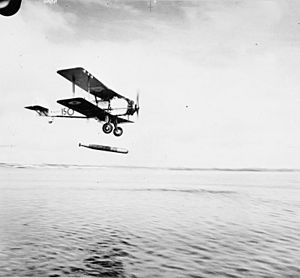
The first air attack was carried out by Vildebeests and Hudsons. Twelve Vildebeests and nine Hudson bombers took off from Singapore in the early afternoon of January 26. They had fighter escorts: twelve Brewster F2A Buffalos and nine Hawker Hurricanes.
By the time the planes arrived at 3:00 PM, the Japanese had been landing troops at Endau for over four hours. The Japanese naval force had air cover from 19 Nakajima Ki-27 fighters and one Nakajima Ki-44 fighter.
Despite strong Japanese resistance, the Allied planes bombed the two transport ships. They also attacked men and equipment on the beach. Five Vildebeests were lost in this attack, including the commander of No. 100 Squadron. One Japanese Ki-27 was shot down.
A second wave of planes left Singapore at 4:15 PM. This group included seven Vildebeests and three Albacores from No. 36 Squadron, and two Vildebeests from No. 100 Squadron. They arrived over Endau at 5:30 PM. Their escort of seven Hurricanes and four Buffalos was late.
Japanese Ki-27s and Ki-44s attacked the British biplanes before their escorts arrived. Five Vildebeests, two Albacores, and one Hurricane were lost in this attack. Out of 72 aircrew from Nos. 36 and 100 Squadrons, 27 were killed, seven were wounded, and two were captured.
A third raid happened shortly after. Six unescorted Hudsons from No. 62 Squadron RAF flew from Palembang, Sumatra. They lost two planes and all their crews to six Japanese Ki-27s. A fourth raid of five Bristol Blenheims from No. 27 Squadron RAF started from Palembang later. But they only reached Singapore by sunset, so they turned back.
The Allied pilots claimed to have hit both transport ships and a cruiser many times. However, neither the transport ships nor their escorts were badly damaged. The transport ships were hit by small pieces of metal, which killed 8 and wounded 18. But the Sendai and smaller ships were not touched.
Rear-Admiral Ernest Spooner, who commanded naval forces in Singapore, ordered his only ready warships to attack the Japanese ships off Endau. These were the old destroyers HMS Thanet and HMAS Vampire.
Commander William Moran was the captain of Vampire, and Thanet was led by Lieutenant Commander Bernard Davies. The destroyers left Singapore at 4:30 PM with Moran in charge. They headed north.
Early reports said the Japanese had about a dozen destroyers protecting the convoy. But this was later changed to just two destroyers, based on incorrect information from Allied aircrew. The Japanese were ready for a surface attack because they also had a wrong report that two British light cruisers were at sea.
Moran led his ships between the Seribuat Archipelago and the coast of Johor. The moon was bright. Then he changed course northeast to search the area north of the islands. When dark clouds covered the moon at 1:51 AM, he turned southwest towards Endau. He kept Tioman Island behind him so his ships would not be seen against the sky.
At 2:37 AM, Vampire saw a Japanese destroyer (likely Amagiri). But the Allied ships were not spotted. They continued their course. Three minutes later, they found another Japanese ship (the minesweeper W-4) directly ahead, very close. Moran decided to attack because they were too close to stay hidden. He increased speed to 25 knots (46 km/h). He fired two of his three torpedoes from about 600 yards (550 m) away. One torpedo missed ahead, and the other passed under the minesweeper.
W-4 was trying to figure out who the two destroyers were when Moran attacked. It did not tell any other Japanese ships about the Allied presence for 20 minutes. W-4 did not fire back. Moran continued searching for the transport ships. He slowed down to 15 knots (28 km/h) to make less wake. Half an hour later, with shallow water ahead and no transport ships found, the Allied destroyers changed course north to leave the shallow area. They increased speed to 25 knots at 3:13 AM before turning southeast by east.
At 3:18 AM, Vampire saw the destroyer Shirayuki ahead and another ship behind. Vampire and Thanet made small course changes to fire their torpedoes at Shirayuki from about 1,500 yards (1,400 m). Vampire fired one, and Thanet fired all four of hers. But all missed. Shirayuki had spotted the Allied ships at the same time. It changed course to get behind the Allied destroyers. Then it signaled to confirm who they were.
Since there was no reply, the Japanese ship lit up the Allied ships with its searchlight. It finally opened fire at 3:31 AM, even though both Allied ships were laying a smoke screen. Moran ordered both his ships to fire back with their four-inch guns. They also retreated southeast at top speed.
Thanet only fired three shots from her guns before she was hit in the engine room. The hit broke the steam lines to her engines, making the ship stop moving and lose all power. The Allied ships kept changing course slightly to make it harder for the Japanese to hit them. Neither Allied ship hit any Japanese ships during the battle.
It is hard to match the Allied and Japanese reports of the gunfight. Especially because the Allied destroyers did not record any times after firing their torpedoes at 3:18 AM. Shirayuki fired 18 rounds at Vampire from about 4,500 yards (4,100 m). Then the blast from her rear guns caused a power failure throughout the ship. Power was back on in two minutes, but the ship had smaller power problems for the next 15 minutes. When it started firing again, Vampire was gone. So Shirayuki aimed at Thanet instead, firing 82 rounds from about 3,050 meters (3,340 yd) away.
Yugiri started firing at 3:38 AM at Thanet from 4,500 yards (4,100 m) away. Both Japanese ships saw their target slowing down at 3:45 AM. At the same time, Yugiri radioed Hashimoto that "The enemy is two destroyers." So Yugiri had seen Vampire as it fled, but lost sight of it 10 minutes later.
Sendai, Fubuki, Asagiri, Amagiri, Hatsuyuki, and W-1 all started firing, mostly at Thanet. Vampire also reported being under fire for a long time. In total, the Japanese ships fired 469 rounds at the Allied destroyers. They did not hit Vampire even once.
Shirayuki reported that Thanet had sunk at 4:18 AM. They rescued an officer and 30 sailors from the water. Another officer and 11 sailors died in the battle. The Japanese did not chase Vampire, and it reached Singapore at 10:00 AM that morning.
What Happened After
Shirayuki gave the rescued sailors to troops on Endau the next day. These sailors were not seen again.
Davies, four other officers, and 61 sailors from Thanet managed to reach shore. They made their way to Singapore, along with some shot-down aircrew.
The Japanese were able to finish landing their troops. This might have made the Australian defenders think there were many more Japanese forces. This led to the Australians retreating later.
The Allied aircraft and aircrew suffered heavy losses. This greatly reduced their ability to help in the ground battles that followed. Moran's report about how poorly the Japanese fought at night was a very important result of the battle.
For a while, Moran's ideas influenced how the Allies thought about the Japanese Navy. But then, the Japanese won a big night battle during the Battle of Savo Island in August. This completely changed what the Allies believed about the Japanese ability to fight at night.


